When fishing in clear water, using the right nymph fly pattern can significantly increase your chances of success. Bob Reece, a seasoned angler and guide, has developed a nymph pattern that mimics the appearance of crawler-type mayfly nymphs, a common food source for trout in clear, slow water. This pattern features a translucent thorax that reflects light, giving it a lifelike appearance.
Bob’s design has proven to be highly effective in catching trout in clear water conditions, particularly during the summer and fall months. The size selection of the nymph pattern may vary depending on the season, with size 12 being commonly used in the summer and smaller size 16s in the fall.
Key Takeaways:
- Using the right nymph fly pattern is crucial for success in clear water fishing.
- Bob Reece’s design mimics the appearance of crawler-type mayfly nymphs.
- The translucent thorax of the nymph pattern gives it a lifelike appearance in the water.
- Vary the size of your nymph pattern based on the season and the presence of larger nymphs.
- Clear water nymph fishing is most effective during the summer and fall months.
Choosing the Right Nymph Fly Pattern
Selecting the right nymph fly pattern for clear water fishing can be crucial to your success. There are several ways to choose a nymph fly that will attract trout in clear water. One method is to identify popular nymphs in the area where you’ll be fishing. These patterns have proven to be effective and are commonly used by anglers.
Another strategy is to seek recommendations from local guides who have extensive knowledge of the area and the most successful fly patterns. They can provide valuable insights into which nymph flies are popular and effective in clear water.
If you prefer a more hands-on approach, you can turn over river rocks and observe the nymphs underneath. This gives you a chance to see what the trout are feeding on and select a pattern that closely matches the natural nymphs in the water. By imitating the local food source, you increase your chances of enticing trout to bite.
Here are some of the top nymph fly patterns for trout in clear water:
- Pat’s Rubber Leg Stone
- TH Zebra Midge
- Flashback Bead Head American Pheasant Tail
- Tunghead Prince
- Barbless Hot Rib Walt’s
Hare’s Ear patterns are also worth stocking in your fly box as they have consistently proven to be successful in clear water conditions. It’s advisable to have a range of sizes, typically from 8 to 22, with sizes 16 to 22 being a good starting point. Adjust the size of your nymph fly based on the presence of larger nymphs in the water.
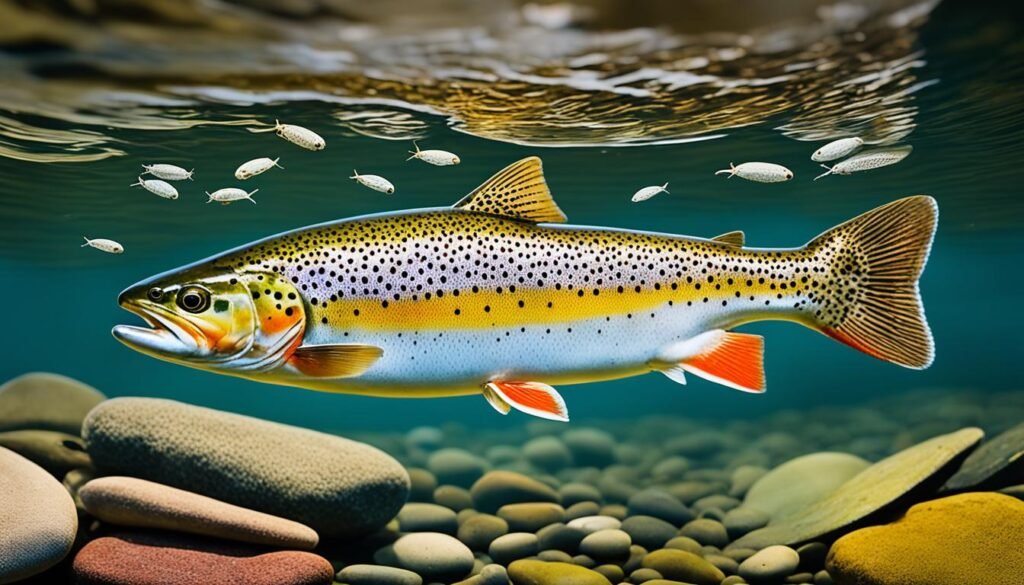
Top Nymph Fly Patterns for Clear Water Fishing
| Pattern Name | Description |
|---|---|
| Pat’s Rubber Leg Stone | A realistic stonefly imitation with rubber legs for added movement. |
| TH Zebra Midge | A simple yet effective midge pattern with a bead head. |
| Flashback Bead Head American Pheasant Tail | A classic pheasant tail nymph with a flash of color. |
| Tunghead Prince | A versatile and effective pattern with a tungsten head for quick sinking. |
| Barbless Hot Rib Walt’s | A highly visible nymph pattern with a hot rib for added attraction. |
Weighted vs. Unweighted Nymphs for Clear Water Fishing
When nymph fishing in clear water, the choice between using weighted or unweighted nymphs can greatly impact your success. Each type of nymph has its advantages and is better suited for specific fishing conditions.
Weighted Nymphs
Weighted nymphs, such as bead heads, are ideal when fishing in strong currents or deep water. The added weight allows them to sink quickly and maintain a stable position in the water column. These nymphs can also be used to add weight to your rig without the need for split shot. In murky or turbulent waters, colorful bead heads can be particularly effective in grabbing the attention of trout.
Unweighted Nymphs
On the other hand, unweighted nymphs are more suitable for casting in shallow waters or when targeting highly pressured fish that may be easily spooked. The absence of weight reduces the noise that occurs when the nymph hits the water, minimizing the chances of scaring away wary fish. Additionally, in high sun conditions, an unweighted nymph is often a better choice as it avoids the potential deterrent effect of light reflecting off a bead head.
By understanding the fishing conditions and the behavior of the fish, you can make an informed decision on whether to use weighted or unweighted nymphs when fishing in clear water.
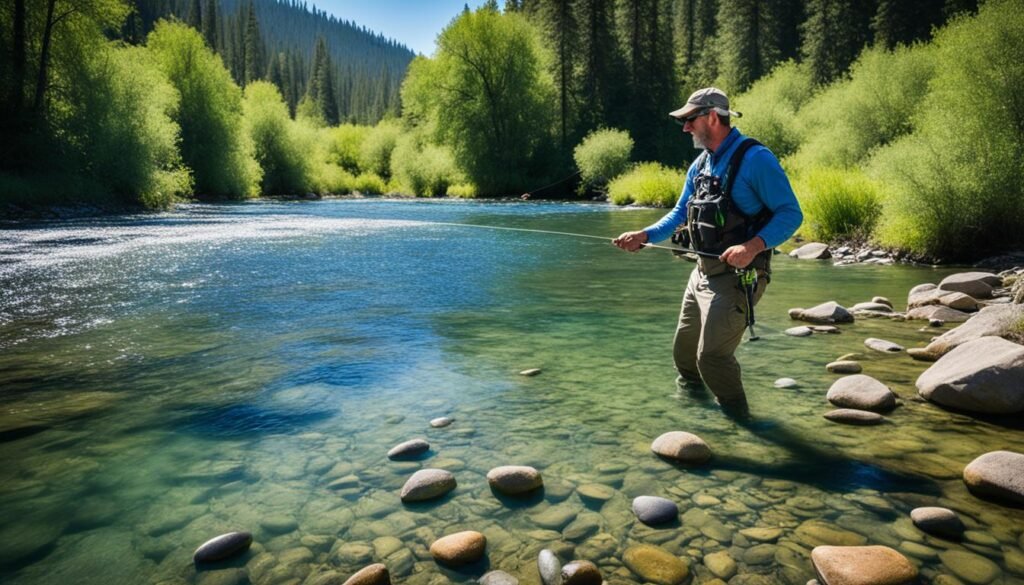
**Table: Comparison of Weighted and Unweighted Nymphs for Clear Water Fishing**
| Aspect | Weighted Nymphs | Unweighted Nymphs |
| ———————– | ———————————————- | —————————————————— |
| Sinking Speed | Sink quickly and maintain a stable position | Float naturally and mimic the movement of living nymphs |
| Fishing Conditions | Ideal for strong currents or deep water | Suitable for casting in shallow waters |
| Noise Impact | Minimal noise upon hitting the water | Potential noise that could spook wary fish |
| Reflective Deterrence | Less affected by light reflecting off a bead | No reflective deterrent effect |
| Visibility in Turbulent | Colorful bead heads can attract attention | Natural appearance blends with the environment |
| Waters | and increase visibility in murky or turbulent | |
In summary, the choice between weighted and unweighted nymphs in clear water fishing relies on various factors, including the fishing conditions and fish species. Experimenting with both types of nymphs and adapting to the specific situation can lead to successful nymph fishing in clear streams and rivers.
Matching Nymph Fly Patterns to Local Hatch
One effective strategy for nymph fishing in clear water is to match your fly pattern to the local hatch. By observing the natural nymphs present in the water, you can select a pattern that closely resembles them. This technique can be particularly successful when targeting selective trout that have become accustomed to feeding on specific nymphs in the area.
Consulting with local experts, such as guides or experienced anglers, can provide valuable insights into the local hatch and help you choose the most expert nymph patterns for clear water fishing.
Presentation Techniques for Clear Water Nymphing
In clear water, the presentation of your nymph fly is crucial to fooling wary trout. To maximize your chances of success, consider using the following presentation techniques:
1. Dead Drift Technique
The dead drift technique involves casting your nymph upstream and allowing it to drift naturally with the current. This mimics the movement of a real nymph and can entice trout to strike. To achieve a natural drift, mend your line as necessary to prevent drag and maintain a lifelike presentation.
2. Reach Cast
The reach cast is a casting technique that allows you to place your nymph fly softly on the water without spooking the fish. It involves using a reach cast to extend your reach and create a drag-free drift. This technique is particularly effective when fishing in clear water where trout are more wary.
3. Short-Line Nymphing
Short-line nymphing, also known as tight-line nymphing or Czech nymphing, involves fishing with little to no fly line on the water. Instead, you use a longer leader and nymph rig to directly control the drift of your flies. This technique allows for precise presentation and better sensitivity to detect subtle takes from trout.
Pro Tip: To enhance the effectiveness of your nymph presentation, regularly monitor the behavior of the trout and adjust your technique accordingly. Pay attention to their feeding patterns and adjust your casting angles, retrieve speed, and depth to match their preferences.
By employing these presentation techniques, you can increase your chances of fooling wary trout in clear water. Remember to observe the behavior of the fish and adapt your approach for optimal results.
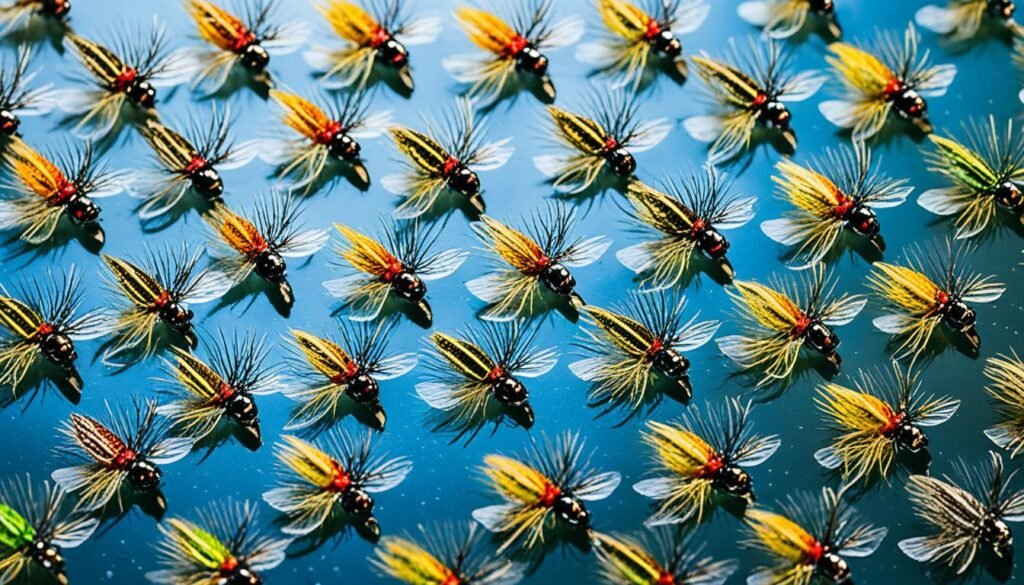
Adding Attractors to Nymph Fly Patterns
When it comes to enticing trout in clear water, incorporating attractor patterns into your nymph fly selection can significantly increase your chances of success. Attractor patterns are designed to grab the attention of trout and trigger a strike response, even if they don’t perfectly match the natural nymphs in the water. These flies are known for their vibrant colors and flashy materials that mimic the natural movement and appearance of prey.
Here are some popular attractor patterns that have proven effective for trout in clear water:
- Prince Nymph: This classic fly features a prominent peacock herl body and white goose biots that imitate various underwater insects. Its flashy appearance and targeted movement can be irresistible to trout.
- Copper John: Named for its copper-colored body, this fly is a staple for many anglers. It incorporates bright colored wire and a flashy bead head, making it a standout attractor pattern in clear water.
- Rainbow Warrior: With its slender body and iridescent materials, this fly mimics the natural iridescence of a midge or other aquatic insects. It’s a go-to attractor pattern for trout in clear water.
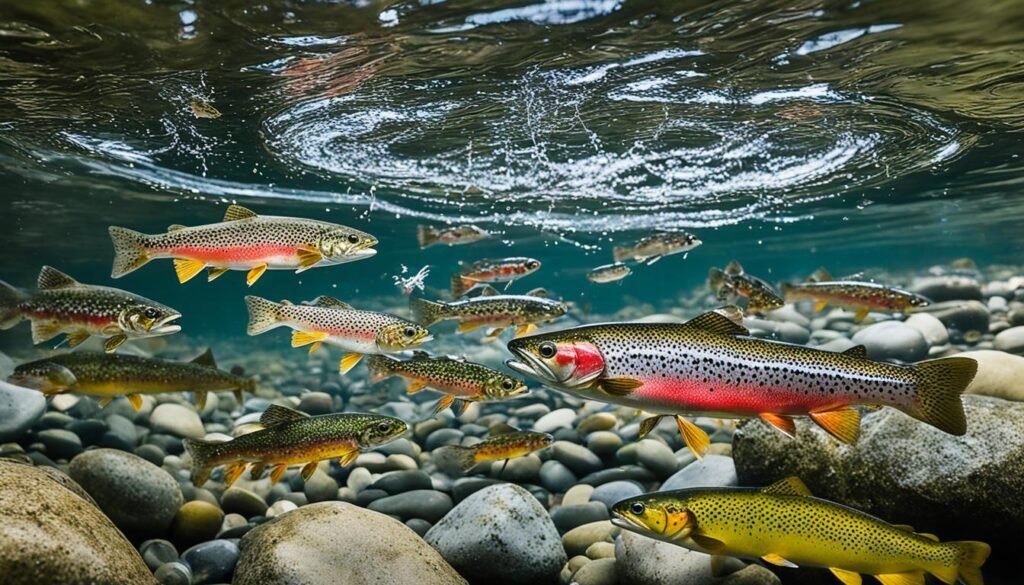
By adding these attractor patterns to your nymph fly selection, you can increase your chances of enticing trout to strike in clear water. The combination of realistic nymph patterns and attention-grabbing attractors creates a balanced approach that can be highly effective in fooling even the most selective trout.
Fine-Tuning Nymph Fly Patterns for Clear Water Fishing
Fine-tuning your nymph fly patterns is essential for success in clear water fishing. By making the right adjustments, you can increase your chances of enticing trout and other fish to strike. Here are some tips to help you fine-tune your nymph fly patterns:
Choose the Right Colors
Experimenting with different colors can make a difference in clear water conditions. Opt for natural hues that closely resemble the local nymphs in the water. Earthy tones like brown, olive, and tan are popular choices. Consider adding a touch of flash or contrast to attract attention.
Size Matters
Adjusting the size of your nymph fly pattern can be crucial in clear water fishing. Pay attention to the size of the natural nymphs present and match your fly accordingly. Start with smaller sizes and gradually increase or decrease until you find what works best.
Add Weight to Sink Faster
In clear water, trout can be picky, and getting your nymph to the right depth quickly is essential. Use weighted nymphs or add weight to your rig to ensure it sinks rapidly and stays in the trout’s feeding zone.
Experiment with Profiles
Varying the profile of your nymph fly pattern can make it more appealing to trout. Try different shapes and silhouettes, such as slender-bodied nymphs, full-bodied nymphs, or even ones with trailing legs. The goal is to imitate the natural movement and appearance of nymphs in the water.
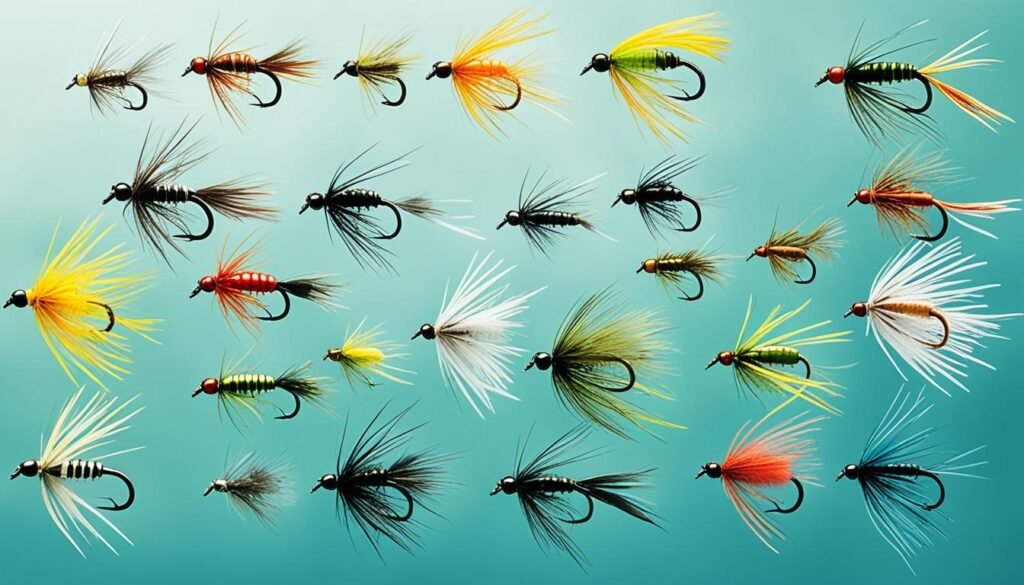
Adding attractors to your nymph fly patterns can also enhance their effectiveness in clear water conditions. Rainbow Warrior, Prince Nymph, and Copper John are popular patterns known for their success. These vibrant and enticing flies can trigger a strike response from trout, even when they don’t closely resemble the natural nymphs.
Remember, fine-tuning your nymph fly patterns is a process of experimentation and observation. Pay attention to the fish’s behavior and adjust accordingly. With practice and persistence, you’ll develop a repertoire of effective nymph fly patterns that consistently catch fish in clear water.
The Importance of Presentation and Stealth in Clear Water Fishing
In clear water, trout are often more cautious and can be easily spooked. To increase your chances of success, it is crucial to prioritize presentation and practice stealth. Here are some tips:
- Approach the water with caution, taking care not to disturb the surrounding environment. Keep a low profile and move slowly to avoid creating unnecessary vibrations that can alert the fish.
- Use longer leaders and finer tippets to provide a more natural presentation. Clearwater trout have keen eyesight, so a subtle presentation can make the difference between success and failure.
- Cast upstream or across the current to allow your nymph to drift naturally towards the fish. Avoid casting directly over fish, as it can startle them and cause them to become wary.
- Keep your false casts to a minimum. Excessive false casting can draw attention and create added movement in the water, potentially spooking the fish.
- Regularly change the position of your nymph fly to vary the presentation. This can simulate the movement of a natural nymph and make your fly more enticing to trout.
- Use a drag-free drift by mending your line to prevent your fly from being pulled unnaturally by the current. This will make your presentation more convincing to the fish.
Remember, presentation and stealth are key components of successful nymph fishing in clear water. By mastering these techniques, you can increase your chances of fooling even the most cautious trout and enjoy a productive day on the water.
Using Nymph Fly Patterns in Different Waters
Nymph fly patterns are not limited to just clear water fishing. While commonly associated with trout, nymphs can effectively attract other species such as bass, panfish, and grayling. It’s important to adapt your nymph selection based on the specific water conditions and target species you’re pursuing.
When fishing in clear streams and rivers, opt for natural-looking nymph patterns that closely mimic the local hatch. These patterns are often the most successful in fooling trout in clear water. By imitating the nymphs that the fish are feeding on, you can increase your chances of a strike and a successful catch.
In murkier or faster-moving waters, a different approach may be necessary. Consider using weighted nymphs and attractor patterns to attract the attention of fish and elicit strikes. Weighted nymphs like bead heads sink quickly and remain stable in turbulent waters, making them effective in such conditions. Attractor patterns like the Prince Nymph, Copper John, and Rainbow Warrior can also grab the attention of fish and entice them to strike, even if they don’t perfectly match the natural nymphs in the water.
Remember, each type of water and species requires a tailored approach. Be adaptable and experiment with different nymph patterns to find what works best for the waters you’re fishing. With the right nymph fly patterns and techniques, you can increase your chances of success in various types of water and expand your angling opportunities.
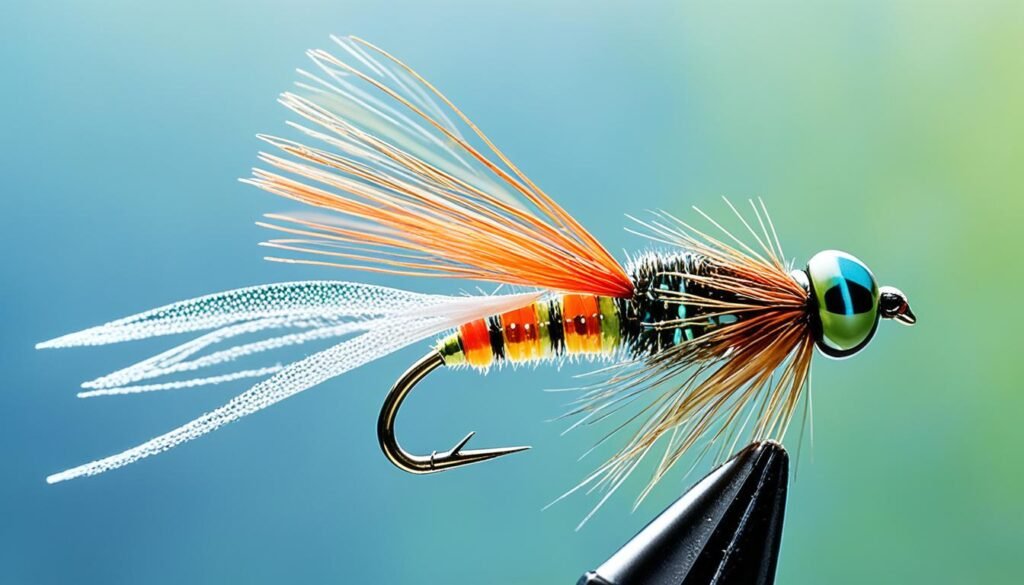
Next, we’ll explore the gear and tackle you’ll need for nymph fishing in clear water.
Gear and Tackle for Nymph Fishing in Clear Water
To effectively fish nymphs in clear water, you’ll need the right gear and tackle. Consider the following:
Rods and Reels
For nymph fishing in clear water, a 9 to 10-foot rod with a 4 to 6 weight is recommended. This will provide sufficient length and power for accurate casts and delicate presentations. Pair your rod with a reel that has a smooth drag system and sufficient backing capacity.
Fly Lines
A weight forward floating line is the most common choice for nymph fishing in clear water. This type of line offers excellent control and allows you to accurately cast and control your drift. Consider using a double taper line for more delicate presentations.
Leaders and Tippets
When nymph fishing in clear water, use a long leader of 9 to 12 feet to provide a natural drift and minimize drag. Opt for fluorocarbon tippet material in 4X to 6X sizes for better visibility in the clear water and increased strength.
Indicator Systems
Using an indicator system is essential for detecting subtle nymph strikes in clear water. Choose an indicator that is highly visible, such as a yarn indicator or a foam indicator, to help you track the movement of your nymph and detect any slight hesitation or deviation in its drift.
Nymph Patterns
When nymph fishing in clear water, it’s important to have a selection of expert nymph patterns in your fly box. Here are some popular and effective nymph patterns for clear water:
| Nymph Pattern | Size | Description |
|---|---|---|
| Pheasant Tail Nymph | 12-22 | A versatile pattern that imitates various nymph species. |
| Hare’s Ear Nymph | 12-20 | Mimics mayfly nymphs and works well in clear water. |
| Copper John | 12-16 | A heavy and flashy pattern that attracts trout in clear water. |
| Zebra Midge | 18-22 | A small and simple pattern that imitates midge pupae. |
These nymph patterns have proven to be highly effective when targeting trout in clear water conditions. Make sure to have different sizes and variations to match the specific insects present in the water.
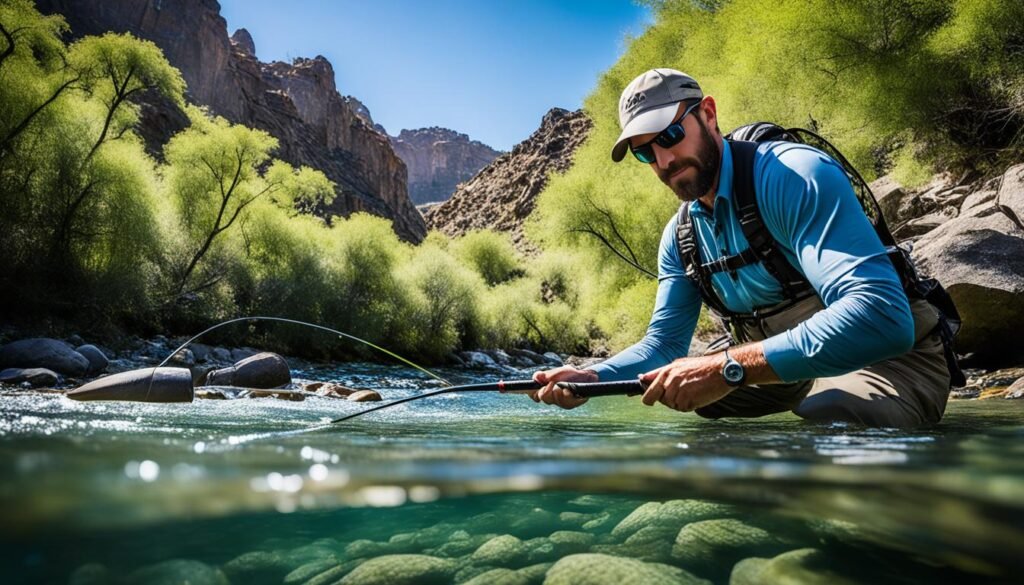
Having the right gear and tackle is crucial for nymph fishing in clear water. With the right equipment and a selection of expert nymph patterns, you’ll be well-prepared to tackle any clear water fishing scenario.
Strategies for Success in Clear Water Nymph Fishing
Mastering the art of nymph fishing in clear water requires a combination of effective strategies. By implementing these proven techniques, you can increase your chances of success and reel in more trout. Here are some strategies to consider:
1. Stealthy Approach
When nymph fishing in clear water, it’s essential to approach the fishing spot quietly and avoid making unnecessary movements. Trout in clear water are easily spooked, so try to stay low and avoid casting a shadow over the area. Take your time and be patient.
2. Perfect Presentation
The presentation of your nymph fly is critical in clear water fishing. Make sure to cast upstream and allow the nymph to drift naturally with the current. Avoid drag by mending the line, ensuring a drag-free drift that mimics the movement of a real nymph. Aim for a subtle presentation that doesn’t alarm the trout.
3. Adjusting Depth
Trout in clear water tend to be more selective, so it’s important to adjust the depth of your nymph to align with their feeding zone. Experiment with different depths by using split shot or adjusting your indicator (if using one). Keep a close eye on any subtle strikes or other signs of trout activity to determine the ideal depth.
4. Focus on Natural Drift
In clear water, trout have a keen eye for detecting unnatural movements. It’s crucial to imitate the natural drift of nymphs by controlling the speed and movement of your fly. Pay attention to the speed of the current and adjust your casting and line management accordingly.
5. Vary Nymph Patterns
Trout in clear water can become highly selective, so it’s important to have a variety of nymph patterns in your arsenal. Experiment with different sizes, colors, and designs to match the local hatch and preferences of the trout. Remember to closely observe the natural nymphs in the water and choose patterns that closely resemble them.
6. Adapt to Changing Conditions
Clear water conditions can change throughout the day due to sunlight, weather patterns, and fishing pressure. Be prepared to adapt your nymph fishing strategies accordingly. Adjust the size and color of your nymphs, change your presentation techniques, and move to different sections of the river if necessary.
“The key to success in nymph fishing is to experiment, observe, and adapt to the conditions and behavior of the trout.” – Bob Reece
Implementing these strategies will enhance your nymph fishing skills and improve your success rate in clear water. Remember, practice makes perfect, so don’t hesitate to spend time on the water refining your techniques. With patience, persistence, and the right nymph patterns, you’ll be well on your way to catching more trout in clear water.
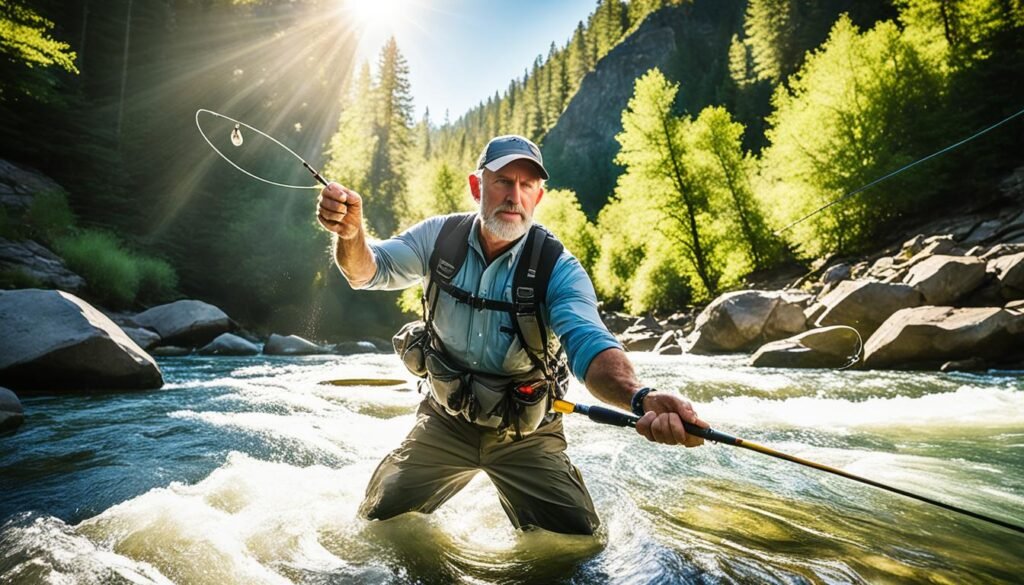
Conclusion
Mastering the art of nymph fishing in clear water is essential for anglers looking to maximize their success. By carefully selecting the right nymph fly patterns, fine-tuning your presentation, and practicing stealth, you can deceive even the most discerning trout in clear water. Adapting your approach based on the prevailing conditions and fish behavior is key to consistently catching trout in clear water. Patience and persistence will reward you with the skills of a skilled nymph angler.
When it comes to nymph fly patterns for clear water, the best patterns are those that closely resemble the natural nymphs found in the area. From Bob Reece’s remarkable crawler-type mayfly nymph pattern to popular designs like the Pat’s Rubber Leg Stone, TH Zebra Midge, and Flashback Bead Head American Pheasant Tail, there are numerous effective flies for clear water fishing. Adding attractor patterns, such as the Prince Nymph or Copper John, can further enhance the effectiveness of your nymph fly selection.
So, gather your gear, select your nymph fly patterns wisely, and embark on thrilling adventures on the water. With dedication and the right techniques, you’ll be well on your way to becoming a skilled nymph angler and consistently catching trout in clear water.
FAQ
What are some popular nymph fly patterns for clear water?
Some popular nymph fly patterns for clear water include the Pat’s Rubber Leg Stone, TH Zebra Midge, Flashback Bead Head American Pheasant Tail, Tunghead Prince, Barbless Hot Rib Walt’s, and Hare’s Ear patterns.
Should I use weighted or unweighted nymphs for clear water fishing?
The choice between using weighted or unweighted nymphs depends on the fishing conditions. Weighted nymphs are ideal for strong currents or deep water, while unweighted nymphs are more suitable for shallow waters or targeting easily spooked fish.
How can I match my fly pattern to the local hatch in clear water?
To match your fly pattern to the local hatch, observe the natural nymphs present in the water and select a pattern that closely resembles them. Consulting with local experts can also provide valuable insights into the local hatch.
What presentation techniques should I use for clear water nymphing?
To maximize your chances of success, consider using techniques such as dead-drifting, high-sticking, and tight-line nymphing. These techniques help create a natural presentation and fool wary trout.
How can I enhance the effectiveness of my nymph fly patterns in clear water?
Adding attractor patterns, such as the Prince Nymph, Copper John, and Rainbow Warrior, to your nymph fly selection can enhance their effectiveness in clear water conditions.
How can I fine-tune my nymph fly patterns for clear water fishing?
Fine-tuning your nymph fly patterns can be done by adjusting the size, color, and materials used. It is important to closely match the natural nymphs in the water and experiment with different variations to determine what works best.
Why is presentation and stealth important in clear water fishing?
In clear water, trout are often more cautious and easily spooked. Prioritizing presentation and using stealthy approaches can increase your chances of fooling wary trout and enticing them to strike.
Can nymph fly patterns be used in different types of water?
Yes, nymph fly patterns can be effective in various types of water, not just clear water. They can attract species such as trout, bass, panfish, and grayling. The choice of nymph pattern should be adapted to the specific water conditions and target species.
What gear and tackle do I need for nymph fishing in clear water?
To effectively fish nymphs in clear water, you’ll need a fly rod, reel, and line suitable for nymphing techniques. It is also important to have a selection of nymph fly patterns, tippet material, and indicators.
What strategies can I use to increase my chances of success in clear water nymph fishing?
Some strategies for success in clear water nymph fishing include matching your fly pattern to the local hatch, fine-tuning your presentation, using attractor patterns, and practicing stealth and patience.

